Situated in the bustling cityscape of Shanghai, the Jade Buddha Temple (玉佛寺, Yufo Temple) stands as a serene sanctuary amidst the urban chaos. Established in the 8th year of the Qing Dynasty’s Guangxu reign (1882), this temple holds a significant place alongside other renowned temples in Shanghai, such as Longhua Temple and Jing’an Temple. The current layout of the Jade Buddha Temple consists of two main sections: the front courtyard, which encompasses the original temple site, and the rear courtyard featuring a multifunctional building called Juequn Dali.
The front courtyard unfolds along a central axis, adorned with architectural marvels such as the grand archway, the Hall of Heavenly Kings, the Mahavira Hall, and the Wisdom Attainment Chamber (with the Jade Buddha Tower and the Scripture Hall on its upper floors). This section boasts a design reminiscent of Song Dynasty palace architecture. In contrast, the rear courtyard is home to the versatile Juequn building. Within the temple precincts, the cultural relics room houses a collection of precious artifacts from the Northern Wei, Tang, Song, Yuan, Ming, and Qing dynasties.
Notably, the Jade Buddha Temple gained prominence for housing two jade Buddha statues brought back from Myanmar by Master Huigen of Mount Putuo during the late Qing Dynasty. Interestingly, while Master Huigen originally acquired a total of five jade Buddha statues, he chose to leave two of them in Shanghai during his return journey to Mount Putuo.
The temple attracts a steady stream of worshippers, especially during the first and fifteenth days of each lunar month when devotees flock to offer incense. One of the temple’s notable events is the burning of the first incense on the first day of the lunar new year, drawing worshippers who eagerly wait outside the temple gates on New Year’s Eve, hoping that their wishes will be granted with the first incense of the year.
Table of Contents
- Basic Information
- Location and Transportation
- Highlights of Jade Buddha Temple
- Map and Recommended Tour
- Vlog about Jade Buddha Temple
- History of Jade Buddha Temple
- Useful Tips Summarized from Reviews
- Other Temples in Shanghai
Basic Information
| website | http://www.yufotemple.com/ |
| Estimated length of tour | 1-2 hours |
| Entrance fee | 20 RMB for admission, and you need to pay an extra of 10 RMB to get into the Jade Buddha Chamber |
| Opening hours | 8.00-16.30 on normal days. The open time may be brought forward to 6.00 am or 7 am on festivals and special occasions. |
| Telephone number | 0086-021-62663688 |
Location and Transportation
Jade Buddha Temple can be found in the Putuo District, in the northwestern part of the city. It is easily accessible by public transportation and is close to several other popular tourist attractions, including the Shanghai Museum, the Shanghai Grand Theatre, and People’s Square.
Bus: Take bus No. 19, 206, 316, 328, or 738, get off at Jiangninglu Anyuanlu Stop, and you will be right in front of its East Gate
Subway: Take subway line 13, get off at Jiangninglu Station, turn left into Jiangning Road, and you will find the temple on your right-hand side after 240 meters. You can also get off at Changshoulu Station on Lines 7 and 13, but you have to walk a longer distance in this case.
Self-drive: There is a parking lot to the south of the temple, at the intersection of Shangxi North Road and Anyuan Road. You can park your car there and enter the temple by the Southeast gate.
Railway: The temple is only 1.6 kilometers away from the Shanghai Railway Station. If you arrive in Shanghai at this station, you can walk there directly.
Highlights of Jade Buddha Temple
The Mahavira Hall
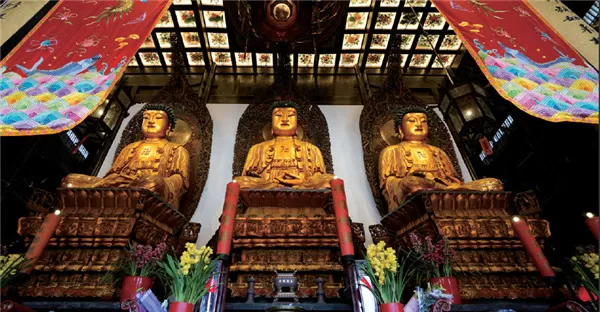
The Mahavira Hall serves as the central edifice in the Jade Buddha Temple, measuring approximately 30 meters in length and 25 meters in width. This two-story palace-style structure, echoing the architectural style of the Song Dynasty, radiates an ancient and solemn aura. At its core, the hall houses three majestic Buddha statues: Shakyamuni in the center, flanked by Amitabha Buddha and Bhaisajyaguru on either side. Seated on lotus thrones, these 4-meter-tall golden-clad statues exude serenity, casting a radiant and dignified atmosphere throughout the hall. Above Shakyamuni’s head, the ceiling features a vivid and captivating depiction of his birth, showcasing a swirling pattern with the playful imagery of his naked form and nine dragons spraying water for his ceremonial bathing – a charming and lively representation.
The Jade Buddhas
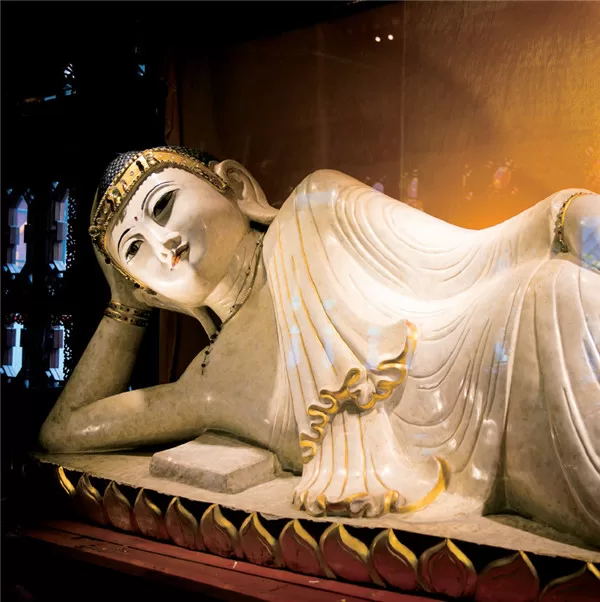
The Jade Buddha Temple houses two remarkable jade Buddha statues, each holding its own significance. The first, located within the Jade Buddha Tower, is a seated statue of Shakyamuni measuring 1.92 meters in height. Adorned with dazzling gold leaf and embedded gemstones, this Buddha is revered as the “treasure of the temple.” The Jade Buddha Tower’s ceiling boasts an additional 500 gold-plated Buddha statues, requiring a separate entrance fee of 10 yuan for visitors.
The second jade Buddha, housed in the reclining Buddha hall on the west side of the temple, is a 96-centimeter-long statue depicting Shakyamuni in a reclined posture, replicating the appearance of his passing at the age of 80. With a serene expression, the reclining Buddha rests on his side, supporting his head with his right hand. Across from the reclining Buddha, a recent addition, approximately 4 meters in length, was donated by Singaporean devotees, enhancing the temple’s spiritual and artistic richness.
The Vegetarian Restaurant
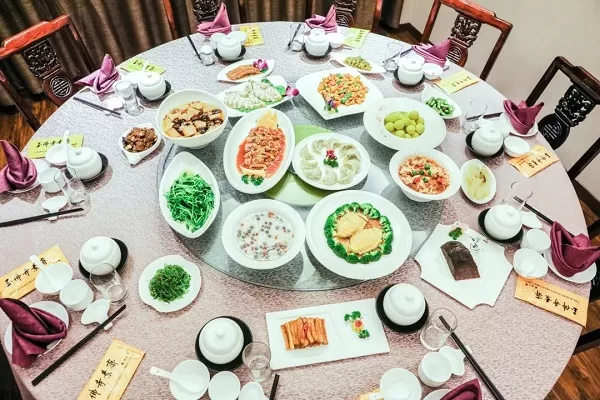
The Vegetarian Restaurant in the Jade Buddha Temple is a popular dining destination for both tourists and locals. As a part of the temple complex, the restaurant is dedicated to providing delicious and healthy meals that are in accordance with Buddhist dietary restrictions. This means that all of the food served here is vegetarian and does not contain any meat, poultry, fish, or eggs.
The menu features a range of dishes, including soups, stir-fries, rice dishes, and noodle dishes, as well as an assortment of snacks and desserts. The food is made with fresh, wholesome ingredients, and the chefs take pride in creating dishes that are both healthy and delicious.
Map and Recommended Tour

Recommended Route: Hall of Heavenly Kings (天王殿) – Hall of Guanyin (观音殿) – Bell Tower (钟楼) – Drum Tower (鼓楼) – Great Buddha Hall (大雄宝殿) – Reclining Buddha Hall (卧佛殿) – Manjusri Hall (文殊殿) – Great Compassion Hall (大悲殿) – Kaalan Hall (伽蓝殿) – Three Saints Hall (三圣殿) – Yao Shi Hall (药师殿) ⬇️Samantabhadra Hall (普贤殿) – Ksitigarbha Hall (地藏殿) – Four-Faced Buddha (四面佛) – Jade Buddha Hall (玉佛殿) – Light Incense and Other Steps
Important Notes:
- No photography of the Buddha statues.
- Keep noise to a minimum.
- Avoid exposing shoulders, and do not wear shorts, skirts, or flip-flops.
- Do not throw coins; place them gently.
Vlog about Jade Buddha Temple
History of Jade Buddha Temple
The Jade Buddha Temple in Shanghai has a rich history rooted in both spiritual devotion and resilience through turbulent times. Established in the late Qing Dynasty, its story begins with Master Hui Gen’s pilgrimage.
In 1882, during the reign of Emperor Guangxu in the Qing Dynasty, Master Hui Gen of Mount Putuo embarked on a spiritual journey that took him across China, through Tibet, and to India. After paying homage in these sacred places, he traveled through Myanmar, where he was sponsored by local Chinese expatriates. Master Hui Gen acquired jade in Myanmar and had it carved into five Buddha statues. These statues were intended for Mount Putuo, a significant Buddhist site. However, during his journey back, he left behind two statues—a seated Buddha and a reclining Buddha—in Shanghai. These statues were enshrined in a temple built in Jiangwan Town, which was named the Jade Buddha Temple.
The original Jade Buddha Temple was constructed in 1900, during the 26th year of the Guangxu reign. It was situated beside the Wusong Jiangwan Station and was managed by Master Ben Zhao, a disciple of Master Hui Gen. However, following the Xinhai Revolution, the temple was destroyed in warfare, with only the jade Buddhas surviving. The temple was temporarily relocated to a villa on Shengtang Road (now known as Wei’an Road), where the jade Buddhas were enshrined.
In 1918, the temple was again destroyed by fire. Consequently, a new temple was built on its current site, and it was renamed “Jade Buddha Zen Temple.” Master Ke Cheng, a monk of the Linji sect of Zen Buddhism, oversaw the construction of the new temple. Over ten years of dedicated effort led to the completion of a series of Song Dynasty-style buildings, including the main hall, pavilions, and dining facilities. This new Jade Buddha Temple was celebrated for its grandeur and architectural beauty, becoming one of the most prominent temples in Shanghai.
In 1942, the temple’s abbot, Master Yuan Chen, founded the Shanghai Buddhist Institute within the temple premises. He invited Master Zhen Hua from the Zhulin Temple in Zhenjiang to serve as the head and academic director of the institute, enrolling 30 student monks. Unfortunately, the institute was later closed for various reasons.
After the establishment of the People’s Republic of China, the state allocated funds for the maintenance and repair of the temple on several occasions. On January 8, 1963, Premier Zhou Enlai personally accompanied Sri Lankan Prime Minister Sirimavo Bandaranaike to the Jade Buddha Temple to attend a memorial service celebrating the 64th anniversary of the birth of Sri Lankan Prime Minister Bandaranaike.
During the Cultural Revolution, under the protection of the municipal government, various levels of government, relevant organizations, and the local community worked together to preserve the temple’s buildings and artifacts. The Buddhist texts, statues, and ritual implements were safeguarded, and the two jade Buddhas remained intact. However, all Buddhist activities were suspended during this period.
Following the end of the Cultural Revolution, the Jade Buddha Temple reopened as a Buddhist activity site, in line with the policy of religious freedom. A “Jade Buddha Temple Management Committee” was established, and monks who had dispersed during the Cultural Revolution began to return. The temple underwent necessary repairs funded by the government.
From the Third Plenary Session of the 11th Central Committee of the Communist Party of China onwards, the management of the temple was entrusted to Buddhist figures from Shanghai, who appointed the abbot and other positions according to the temple system. In 1979, Master Zhen Chan was appointed as the abbot, restoring the traditional monastic system of the Ten Directions. From 1981, the temple resumed various Buddhist ceremonies and rituals.
In 1983, the Shanghai Buddhist Association reestablished the Shanghai Buddhist Institute at the Jade Buddha Temple, marking a significant revival of Buddhist education and practice in the region.
Useful Tips Summarized from Reviews
Try Vegetarian Noodles at the Vegetarian Restaurant: At the vegetarian restaurant inside Jade Buddha Temple, you can queue up to order vegetarian noodles priced between 25 to 30 yuan per bowl. They offer various options such as double mushroom noodles and arhat noodles, along with a selection of dim sum and ice cream.
Prepare Some Change for Donation Boxes: It’s customary to donate to the temple after your visit. You’ll find donation boxes in each hall, where you can contribute a small amount as a token of gratitude for the spiritual experience.
Be Cautious of Fortune Tellers: Before entering the temple, you may encounter strangers offering to read your fortune. It’s advisable not to trust them and politely decline their services to avoid any potential scams.
Visit the Coffee Shop Across the Temple: Across from the temple, there’s a popular coffee shop called Fangtan (方壇), known for its delicious coffee and elegant ambiance. It’s a great place to relax and enjoy a cup of coffee after exploring the temple.
Try Zen Tea: Adjacent to the Jade Buddha Hall, you’ll find a Zen tea stall offering a special tea called “Zhiyue Zen Tea” for 20 yuan per cup. During winter, they serve a warming drink made with ginger, jujube, honey, and tangerine peel, perfect for chilly days.

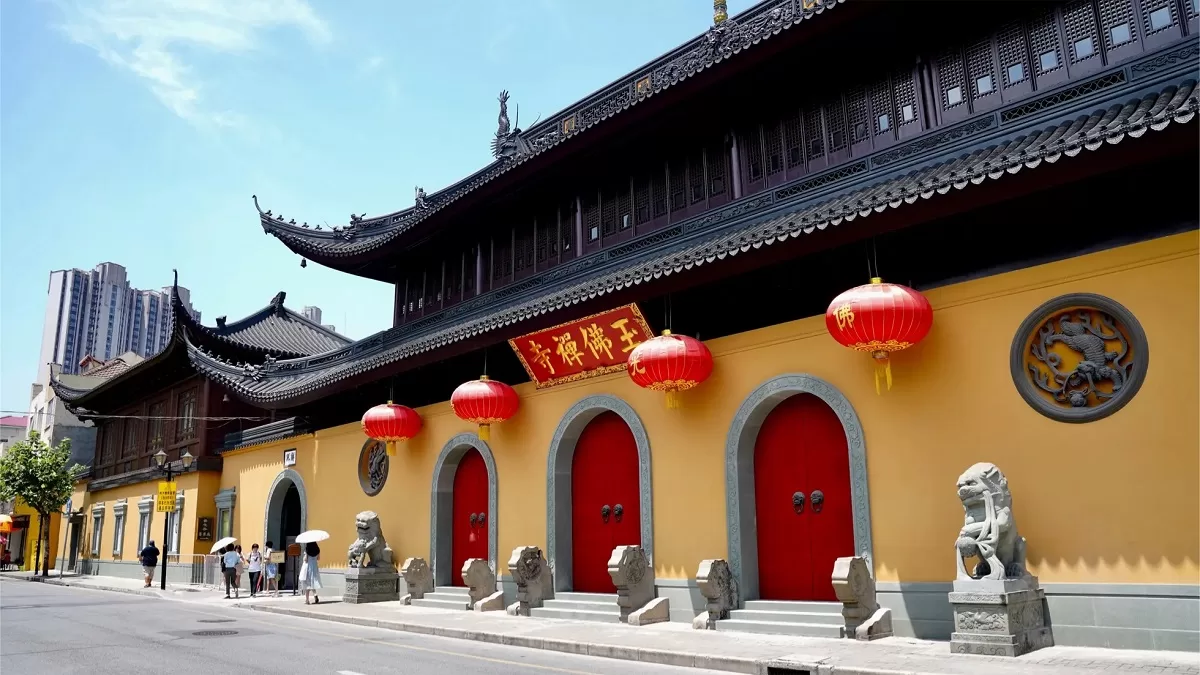

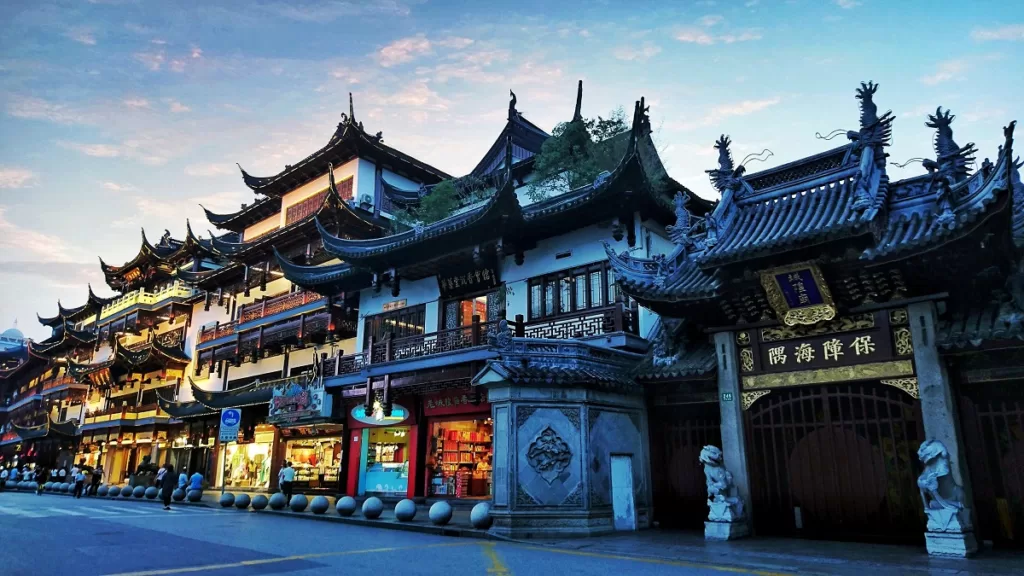


The Jade Buddha Temple is located near the Puxi Jinan Metro Station in Shanghai. It doesn’t require an entrance fee and is less crowded than Longhua Temple.
Today is the third day of the Qingming Water and Land Dharma Assembly at the Jade Buddha Temple. The weather is nice and sunny. I arrived around 1 PM. I prayed, burned some joss paper, and took a stroll around. I had a bowl of vegetarian noodles and bought some vegetarian duck.